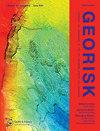利用卫星图像评估巨潮地区工程工程的影响——以法国圣米歇尔山湾为例
IF 4.8
3区 工程技术
Q1 ENGINEERING, GEOLOGICAL
Georisk-Assessment and Management of Risk for Engineered Systems and Geohazards
Pub Date : 2023-11-10
DOI:10.3390/geohazards4040026
引用次数: 0
摘要
圣米歇尔山因其独特的自然景观和位于岩石小岛顶部的中世纪修道院而闻名于世。但这座山也位于一个河口建筑群内,这是相当淤积的。20年来,人们计划进行大规模的工程,以防止这座山被不断扩大的盐田包围。在库埃斯农河上建造一座新水坝,挖掘两条新渠道,以及破坏堤道是2007年至2015年期间进行的主要工程。遥感方法完全适合于评估工程项目的实际影响,特别是重建山周围海洋景观的预期大规模水沉积效应。不同渠道的迁移和植被的时空侵蚀-进积平衡是研究的主要特征。2007年至2023年间,盐田的侵蚀主要发生在西南方,而东南部则较为有限。在同一时期,海湾东北部的泥沙淤积明显增加,似乎也面临同样的淤积问题。现阶段,该工程项目的遥感调查结果喜忧参半。本文章由计算机程序翻译,如有差异,请以英文原文为准。
Evaluating the Impact of Engineering Works in Megatidal Areas Using Satellite Images—Case of the Mont-Saint-Michel Bay, France
The Mont-Saint-Michel is known worldwide for its unique combination of the natural site and the Medieval abbey at the top of the rocky islet. But the Mont is also located within an estuarine complex, which is considerably silting up. For two decades, large-scale works were planned to prevent the Mont from being surrounded by the expanding salt meadows. The construction of a new dam over the Couesnon River, the digging of two new channels, and the destruction of the causeway were the main operations carried out between 2007 and 2015. The remote sensing approach is fully suitable for evaluating the real impact of the engineering project, particularly the expected large-scale hydrosedimentary effects of reestablishing the maritime landscape around the Mont. The migration of the different channels and the erosion-progradation balance of the vegetation through space and time are the main features to study. Between 2007 and 2023, the erosion of the salt meadows was significant to the south-west of the Mont but more limited to the south-east. During the same period, the sedimentation considerably increased to the north-east of the Bay, which seems to be facing the same silting-up problem. At this stage, the remote-sensing survey indicates mixed results for the engineering project.
求助全文
通过发布文献求助,成功后即可免费获取论文全文。
去求助
来源期刊
CiteScore
8.70
自引率
10.40%
发文量
31
期刊介绍:
Georisk covers many diversified but interlinked areas of active research and practice, such as geohazards (earthquakes, landslides, avalanches, rockfalls, tsunamis, etc.), safety of engineered systems (dams, buildings, offshore structures, lifelines, etc.), environmental risk, seismic risk, reliability-based design and code calibration, geostatistics, decision analyses, structural reliability, maintenance and life cycle performance, risk and vulnerability, hazard mapping, loss assessment (economic, social, environmental, etc.), GIS databases, remote sensing, and many other related disciplines. The underlying theme is that uncertainties associated with geomaterials (soils, rocks), geologic processes, and possible subsequent treatments, are usually large and complex and these uncertainties play an indispensable role in the risk assessment and management of engineered and natural systems. Significant theoretical and practical challenges remain on quantifying these uncertainties and developing defensible risk management methodologies that are acceptable to decision makers and stakeholders. Many opportunities to leverage on the rapid advancement in Bayesian analysis, machine learning, artificial intelligence, and other data-driven methods also exist, which can greatly enhance our decision-making abilities. The basic goal of this international peer-reviewed journal is to provide a multi-disciplinary scientific forum for cross fertilization of ideas between interested parties working on various aspects of georisk to advance the state-of-the-art and the state-of-the-practice.

 求助内容:
求助内容: 应助结果提醒方式:
应助结果提醒方式:


